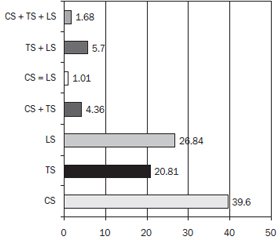Журнал «Боль. Суставы. Позвоночник» Том 13, №3, 2023
Вернуться к номеру
Пошкодження хребта як компонент політравми в постраждалих унаслідок ДТП
Авторы: S.O. Guryev (1), V.A. Kushnir (1, 2), N.I. Iskra (3), H.P. Kushnir (1)
(1) — State Institution “Ukrainian Scientific and Practical Center for Emergency Care and Disaster Medicine of the Ministry of Health of Ukraine”, Kyiv, Ukraine
(2) — Institute of Public Administration and Research in Civil Protection, Kyiv, Ukraine
(3) — Shupyk National Healthcare University of Ukraine, Kyiv, Ukraine
Рубрики: Ревматология, Травматология и ортопедия
Разделы: Клинические исследования
Версия для печати
Актуальність. Дорожньо-транспортна травма залишається одним із тяжких та складних поранень людини як в Україні, так і в усьому світі. Мета дослідження: визначити місце та обсяг пошкоджень хребта як компонента політравми внаслідок дорожньо-транспортної пригоди (ДТП). Матеріали та методи. Сформовано масив дослідження в обсязі 298 пацієнтів із пошкодженням хребта із загальної кількості постраждалих внаслідок ДТП (1696 осіб), які проходили лікування в лікарні швидкої медичної допомоги Києва, лікарні швидкої медичної допомоги Чернівців та трьох центральних районних лікарнях Київської області в 2020–2021 роках. Масив дослідження сформовано методом безповоротної рандомізації із застосуванням технології випадкових чисел. Критерієм включення була наявність пошкодження хребта внаслідок ДТП. Характер травми на цьому етапі визначався тільки за клініко-анатомічною ознакою (шийний, грудний та поперековий відділи хребта). Результати. Установлено, що 87,25 % осіб отримують пошкодження одного відділу. Травма всіх відділів хребта при ДТП зустрічається в 1,68 % випадків. Серед поєднаних пошкоджень найбільшу питому вагу мають травми грудного й поперекового відділів. Травма хребта найбільш часто зустрічається у водіїв (37,05 %), найрідше — у пішоходів (30,82 %). За шкалою тяжкості пошкодження NISS 51,02 % пацієнтів отримали легку травму хребта, 39,99 % — тяжку. У постраждалих із тяжкістю в 25 балів пошкодження шийного відділу хребта мають найбільшу питому вагу (40,29 %), грудного відділу — найменшу (28,70 %). Водії та пасажири найбільш часто зазнають травми шийного відділу хребта — 53,85 та 48,91 % відповідно, а пішоходи — поперекового (47,19 %). Коефіцієнт пошкодження одночасно кількох відділів хребта у водіїв та пасажирів становить 1,14, а в пішоходів — 1,6. Висновки. У постраждалих внаслідок дорожньо-транспортних пригод травма хребта зустрічається в 17,98 % випадків. Найчастіше пошкоджуються шийний (46,64 %), грудний (32,55 %) та поперековий відділи (35,23 %).
Background. Road traffic injury remains one of the most serious and complex types of human injury both in Ukraine and around the world. The purpose of the research: to determine the location and extent of spinal cord injuries as a component of polytrauma as a result of a road accident. Materials and methods. We formed a study array of 298 victims with spinal cord injuries from the array of road accident victims (1,696 people) who were treated in the emergency medical care hospital of the city of Kyiv, the emergency medical care hospital of the city of Chernivtsi, and three central district hospitals of the Kyiv region in 2020–2021. Formation of the research array was carried out by the method of irreversible randomization using the technology of random numbers. The selection criterion for inclusion in the study was the presence of spinal cord injury in road accident victims. At the same time, verification of the nature of the damage was determined at this stage of the study only by clinical and anatomical features, namely, the cervical spine, the thoracic spine and the lumbar spine. Results. It was established that 87.25 % receive damage to one part of the spine. Damage to all parts of the spine in road accidents occurs in 1.68 %. Among the combination of injuries of the spine, the combination of injuries of the thoracic and lumbar parts has the largest specific weight. Spinal cord injury occurs most often in drivers 37.05 %, the least common in pedestrians 30.82 %. According to the NISS, 51.02 % of victims receive a mild spinal cord injury, 39.99 % of victims receive a severe spinal cord injury. In victims with a severity of 25 points, damage to the cervical spine has the largest specific weight of 40.29 %, the smallest is the thoracic section of 28.70 %. In drivers and passengers, the cervical spine is most often damaged, 53.85 and 48.91 %, respectively. In pedestrians, the lumbar spine is most often injured, 47.19 %. The coefficient of combination of damage to several sections of the spine at the same time for drivers and passengers is 1.14, and for pedestrians — 1.6. Conclusions. Spine injuries occur in 17.98 % of victims of traffic accidents. Most often, the cervical spine is damaged in 46.64 %, thoracic — in 32.55 %, and lumbar — in 35.23 % of those injured as a result of traffic accidents.
дорожньо-транспортна пригода; дорожньо-транспортна травма; травма хребта; політравма; постраждалі
traffic accident; traffic injury; vertebral injury; polytrauma; victims

